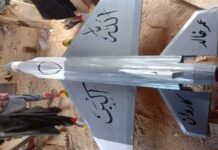India’s nuclear planning has a fatal flaw. There is no clarity on who will be in charge of our nuclear arsenal in case Delhi is wiped out in a nuclear strike. Clever enemies can exploit this weakness.
India has some 156 nuclear warheads according to the latest report of the Stockholm International Peace Research Institute, compared to 165 of Pakistan and 350 of China.
In India, the officially declared position since 2003 is that the ‘Nuclear Command Authority’ comprises a ‘Political Council’ and an ‘Executive Council’. The Political Council is chaired by the prime minister. It is the sole body which can authorize the use of nuclear weapons.
The Executive Council is chaired by the National Security Advisor. It provides inputs for decision making by the Nuclear Command Authority and executes the directives given to it by the Political Council. The Strategic Forces Command is responsible for managing and administering all strategic forces.
Nowhere does it discuss the possibility of what the nation will do if the Political Council itself is wiped out in a surprise pre-emptive nuclear strike on Delhi!
In a May 2020 paper titled ‘Command and Control of India’s Nuclear Arsenal’ in Journal for Peace and Nuclear Disarmament, Lauren J. Borja et al also raise questions about who ultimately controls these weapon systems and how that control is exerted. Could they have been used by military personnel in the event of an attack from the other side, or were they tightly controlled by the political leadership? They argue that it is possible that India’s nuclear command and control system might have a large overlap with conventional systems. This raises the risk of entanglement and, in some cases, a greater possibility of unauthorized or accidental use. However, even this does not discuss the eventuality that I apprehend.
India’s basic understanding of a nuclear war is flawed
Nuclear warfare is under no obligation to follow a prescribed progression. It can take several courses depending on how a country assesses the situation and then calculates the likely enemy response. It is a popular fallacy to think that Pakistan will necessarily open up with battlefield tactical nuclear weapons to blunt a conventional Indian offensive and an outraged India will respond with massive counter-value retaliation against Pakistani cities.
If the whole thing were to be so straitjacketed and so certain, why would Pakistan wait for India’s massive strike? If they have an early warning system and if they have any intelligence network worth its name, they should get a warning that India is considering a massive strike. In that case, they must launch them ASAP before the Indian missiles fall. It would be foolish, utterly foolish on their part to first use tactical nukes and then wait for India’s massive strike.
Hence, it is quite possible that Pakistan or China would go for a surprise pre-emptive strike at the very nerve centre of India, that is, Delhi.
For example, if the Pak army is faring badly in a conventional war, they could very well go straightaway for a strategic nuclear strike.In case of China, they might not be interested in a prolonged conventional slugfest with India in Ladakh or elsewhere, which might witness US involvement and thus complicate matters for them. In that case, they might want to finish the matter for once and all by nuking Delhi.
As far as Pakistan is concerned, I agree with Michael Krepon that the circumstances under which Pakistani leadership would resort to the first use of nuclear weapons have been deliberately kept somewhat imprecise and somewhat vague, in spite of whatever Gen. Khalid Kidwai had famously spoken about the so-called Nuclear Red Lines of Pakistan. The reason is quite simple—making the Red Lines very clear might embolden India to take military actions just beneath them.
Other Nuclear Powers Understood this Problem & Accordingly Devised Means
Other nations of the world were acutely aware of this complex problem and had devised and implemented programs accordingly. Indians, in their quintessential intellectual bankruptcy, have done nothing in this regard—at least not in the public domain.
American Air-Borne Command Posts and Succession
During the years of the Cold War, the SAC (Strategic Air Command) also maintained the National Emergency Airborne Command Post (NEACP, pronounced ‘kneecap’), also known as ‘Looking Glass’,” which consisted of several EC-135s, one of which was airborne at all times. The idea was to ensure the survival of the top command even in the face of national devastation so that military response could be made properly.

However, since there was no guarantee that the airborne plane would notbe shot down or become a victim of EMP (electromagnetic pulse) generated by at, they brought in the Twenty-Fifth Amendment in 1967 to plug in the gaps left by the Presidential Succession Act of1947. The then vice president Richard Nixon himself explained, “With the advent of the terrible and instant destructive power of atomic weapons, the nation cannot afford to have any period of time whenthere is doubt or legal quibbling as to where the ultimate power to use those weapons resides.”Under this, in case of any incapacitation of the president or his becoming unable to discharge the powers and duties of his office for whatever reason, the vice president with a majority of the principal cabinet members would follow a laid down procedure and assume executive authority.
Soviet Fail-deadly Option
The term fail-deadly was coined as a contrast to fail-safe.The Soviet Union used a fail-deadly system known as Dead Hand (codenamed ‘Perimeter’). Under this system, policies and procedures controlling the retaliatory strike would authorize launch even if the existing command and control structure had already been neutralized by a first strike. It is believed that modern Russia very wisely continues the system. Harold Coyle writes in his book ‘Dead Hand’ that the system would automatically launch their ICBMs (Inter Continental Ballistic Missiles) if a nuclear strike was detected by seismic sensors, light, radioactivity, and overpressure sensors.
UK’s Letters of Last Resort
England is a small country. It could get easily wiped out in a nuclear strike. Hence it keeps most of its nuclear strike capability (about 120 nuclear warheads) in its four Vanguard class Trident nuclear submarines. Now the question is what they would do if the top command is eliminated? The system of the Letters of Last Resort was invented to enable them to continue retaliation even after the mainland was devastated. They contain orders on what action to take in the event of an enemy nuclear strike having destroyed the British government.
Now, how would a submarine commander somewhere deep inside the ocean find out that England has been destroyed?According to Peter Hennessy’s book ‘The Secret State: Whitehall and the Cold War, 1945 to 1970’, the commander would determine it by two means. If BBC Radio 4 has stopped transmitting or if there are no naval broadcasts for four hours, it would mean that the mainland is gone. While the contents of these letters are secret, according to the December 2008 BBC Radio 4 documentary ‘The Human Button’, four options are given to the submarine commander: retaliate with nuclear weapons; not retaliate; use his own judgement; or place the submarine under an allied country’s command, if possible. The documentary mentions Australia and the United States.
India’s nuclear muscle would be useless if there is no brain to control it
The examples of the three major nuclear powers would convince you that they are very much concerned of the possibility of the top leadership perishing in a nuclear attack or otherwise. None of these countries have kept their arrangement a secret but in India, everything is shrouded in mystery and for which the nation might pay a heavy price.
There is no logical reason to be so secretive about it. There is no logical reason to believe that our great popular leaders have divine protection and they can never be killed.

Even a nation like the USA realized that underground bunkers, howsoever strong, might not survive a surface nuclear burst. That is why they had established the Alternate National Military Command Center at Raven Rock, Maryland. The US navy even deployed a modified cruiser USS Northampton located in the Chesapeake Bay as a National Emergency Command Post Afloat (NECPA). The EC-135s were later replaced by E-4s in the 1970s. During Clinton’s presidency, they introduced Boeing VC-25A also, which duplicated some of the NEACP’s command and control functions.
The Great Indian Nuclear Dilemma
Our entire nuclear arsenal would be laying waste if there is no designated succession authority with the requisite knowledge, understanding and competence to carry on a war. Merely naming someone or some people as successors is not enough. They must be trained or groomed to be worthy successors and must constantly be in the loop. If such people are named who, until the other day, had only as much understanding of a war as they gleaned from TV debates, the nation would be inviting disaster. They could order such wrong use of the nuclear weapons that could draw completely debilitating nuclear strikes from the enemy.
How easily can Delhi be knocked out in a nuclear strike?
Our greatest fatal weakness is that all our political and military command structure is concentrated in Delhi—in fact, within a circle of a diameter of a couple of kilometres only.
If an enemy wanted to eliminate the entire city of Delhi with most of the population killed and critical buildings destroyed, they would require a megaton hydrogen bomb exploded in an air-burst at about 6,000 feet.
Since the Pakistani nuclear weapons are believed to be less than 40 kilotons, they would require multiple strikes spread carefully over those areas of New Delhi, which house critical government offices and residences of those in power.
The Lutyens’ Bungalow Zone itself is about 28 sq km and one Hiroshima size bomb is good for about 12 sq km.To ensure that the entire Indian higher political and military command structure is destroyed in one strike, they will have to use a combination of surface and air-bursts. Given that anti-ballistic missile systems across the world are of questionable merit, there are reasons to believe that enemy missiles can easily get past the layered defences, which India is supposedly putting up around Delhi.
Let us not run away from the unthinkable
The people of the country have hitherto refused to even think along these lines—as if it is unthinkable. What Humphrey Hawksley wrote in his fiction ‘Dragonfire’ about India surrendering unconditionally after China nukes Delhi with a single hydrogen bomb, could well become reality because that fits excellently into the Indian mind-set.
By designating lines of succession and by making it known that they would continue to fight back in a coherent manner even after the leadership is destroyed, the superpowers prepared their people mentally for devastation.
If Indians refuse to discuss such things, they would be in for a great shock when nuclear weapons strike their nerve centre, namely, Delhi. The nation would in fact be mentally paralyzed and would not be able to respond in a reasonable manner.
Such vital matters as succession for nuclear authority should not be left to the realm of speculation and cheap thrillers. A nation exists for its people and for nothing else. The people have a right to know what will happen to them if the top leadership falls—who will defend them, with what and how?
Disclaimer: The information, ideas or opinions appearing in this article are those of the author and do not necessarily reflect the views of N4M.
Also Read:
- June 28, 2024
- June 6, 2024
- June 1, 2024
- May 17, 2024
- May 1, 2024
~ News4masses is now also on Google news
~ If you want to contribute an article / story, please get in touch at: news4masses[at]gmail[dot]com




















Our social media marketing service is designed to boost your online presence and effectively engage your target audience. We create compelling content, craft eye-catching visuals, and execute data-driven strategies to drive traffic, increase brand awareness, and foster customer loyalty. Let us help you harness the power of social media to grow your business and achieve your marketing goals.
There is a saying:
“The More you Sweat in Peace,
The Less You Bleed in War”
Every Security doctrine emphasizes preparing for the most bizarre of eventualities that need to be made a part of a Nations War Plan. It’s incumbent on the govt to ensure that points like these, brought up so vividly by one of the most Senior Professionals in the Security domain, Shri NC Asthana, IPS (Retd) . Kudos to Mr Asthaana foreign bringing such an important point to notice. Hope Modi Ji’s govt acts on this & gets it implemented asap.
Best Wishes